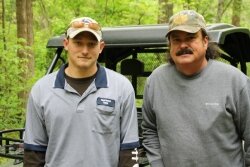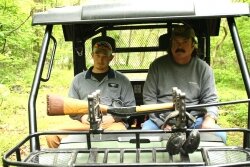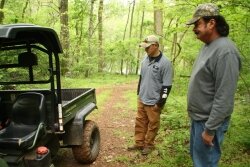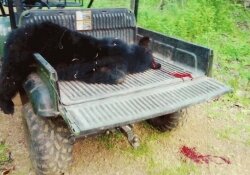Survival story: How they defeated a rabid bear
-
 Patrick Thompson and Bobby Bryant both use the word "unreal" to describe the attack.photo by lisa provence
Patrick Thompson and Bobby Bryant both use the word "unreal" to describe the attack.photo by lisa provence -
 Thompson and Bryant in the Gator with the bird gun that stopped the bear.photo by lisa provence
Thompson and Bryant in the Gator with the bird gun that stopped the bear.photo by lisa provence -
 At the scene of the attack: Thompson and Bryant examine the rear bed of the Gator where the bear was shot. WARNING: Next photo is graphic.photo by lisa provence
At the scene of the attack: Thompson and Bryant examine the rear bed of the Gator where the bear was shot. WARNING: Next photo is graphic.photo by lisa provence -
 The bear died on the back of the Gator.photo by patrick thompson
The bear died on the back of the Gator.photo by patrick thompson
Running into a rabid bear can pretty much ruin your morning, according to two men who survived to tell the tale of Virginia's first-ever reported rabid bear, an encounter that occurred in the neighborhood of the hiker-heavy Appalachian Trail and the family-friendly Skyline Drive.
It started out a pretty typical day for Bobby Bryant, the farm manager at Royal Orchard, the 2,800-acre estate on Afton Mountain that used to provide Albemarle Pippins to Queen Victoria and is owned by the Scott family of Scott Stadium and Scott & Stringfellow brokerage-firm fame.
Bryant, a 56-year-old Afton native who's worked on the estate since 1985, and 22-year-old co-worker Patrick Thompson headed out shortly after 7am on Tuesday, April 17 in a Gator, a popular utility vehicle from John Deere. They drove to the trout pond near Interstate 64– about two-and-a-half miles from the Scott Castle– to dump some rock on the dam.
They were heading back when there was movement up ahead to the right, and the younger man suddenly said, "Look at that bear."
Seeing bears at Royal Orchard is not unusual, according to Bryant, who reports that bears typically retreat at the first sight of humans. This was not your average bear.
"We proceeded on," says Bryant, who noticed something strange: the bear was headed towards them, and then "kept on at us."
Before they could steer clear, the animal ran into their path– and then assaulted their vehicle.
"The bear attacked the Gator," says Bryant.
He says the marauder quickly began chomping the passenger-side front tire and then started attacking the fender. Seated closest to the onslaught, the younger man recoiled from the prospect of becoming a meal, and that's when the situation became more perilous.
"Patrick was on the passenger side, and he comes across me and knocks me off," says Bryant.
That put the two men outside of the vehicle and in the presence of a deranged omnivore. Fortunately for them, the Gator started rolling backward, running over the bear's hind leg.
Bryant, ever the responsible farm manager, was concerned about the pricy vehicle (new Gators retail for over $11,000) rolling back into the pond.
"I chased the Gator to put the handbrake on," says Bryant, "and then the melee starts."
Bryant says they almost always keep a 20-gauge shotgun on board. Fortunately, this was one of those days.
"The bear starts chasing us around the Gator," recounts Bryant. "I had the gun, and I wasn't able to get a shot off. Patrick jumps on the roof. I tossed it to him, going, 'Shoot him.' The bear was right behind me trying to eat me."
A single shot rang out.
"The bear was killed on the back of the Gator," says Bryant. "It happened so fast. It was so unreal."
The shooting sounds like something out of The Terminator.
"Patrick pushed me out of the way with his left arm," says Bryant. "He fired with one arm like a pistol. It hurt his arm."
The shaken men called 911, and animal control from Albemarle and a state game conservation officer came out and cut off the bear's head.
"The protocol with erratic animals is to cut the head off," explains Jaime Sajecki, bear project leader with the Department of Game and Inland Fisheries. The head was shipped off and tested for rabies. The result: positive.
"That's the only rabid bear we know of in Virginia," says Sajecki. And it's only the second documented one on the East Coast. (The first, she says, was reported in Maryland five years ago, when a family in the rural western part of the state, according to a Washington Post account, had to fend off a 134-pound sow trying to break into their home.)
As for the Royal Orchard bear, Sajecki says this was "an older female with no cubs," something she says she knows because the she-bear was not lactating. And Bryant notes that the teeth of the 120-pound ursine were worn down "like they'd been filed."
The marauding bear most likely contracted rabies by getting bitten by an infected animal like a raccoon, says Sajecki, noting that after the positive test result, the bear's carcass was removed the next day to Harrisonburg to be incinerated.
"It's a completely unusual occurrence," says Sajecki, asserting that social animals like raccoons are more typically exposed, not more solitary creatures like bears.
"We don't want people to think every bear they see in the middle of the day is rabid," says Sajecki. "They don't usually chase moving vehicles. We think this was an isolated incident."
According to the Virginia Department of Health, Albemarle officials reported just one rabid animal in 2011, five in 2010, and four in 2009. So far this year, three rabid animal cases have been reported.
And Dr. Lillian Peake with the Thomas Jefferson Health District reminds citizens not to feed wild animals and urges keeping pet vaccinations up to date.
"Rabies is still endemic among raccoons," says Peake. "We see them every year, along with skunks, foxes, and sometimes bats. It's very rare to see it in bears."
Peake notes that the rabies virus can only be transmitted via saliva or brain tissue, typically from a bite that breaks the skin, something that Bryant says that neither of the two men experienced.
"The virus doesn't survive very well in the environment," says Peake. "It's killed by sunlight, or when the saliva dries."
The disease is not spread through blood or urine. But if left untreated, it is fatal.
The attack prompted a joint press release from the Department of Game and Inland Fisheries and the Virginia Department of Health, reassuring the public of the rarity of the attack and reminding them to take precautions with wild animals.
What the release doesn't do is advise what to do when charged by a rabid bear.
"If a rabid bear runs at you, there's not much you can do," says author/hunter Jackson Landers. "You can't outrun a bear. If you're not armed, you're doomed."
As for the 20-gauge shotgun that dropped the bear, Jackson marvels.
"That's a popgun," says Landers. "That would be considered a very light gun."
There's one more salient detail about that blast from the roof of the Gator: that shotgun holds just one shell. And Landers notes only a close-range shot could have stopped such a large mammal. He says that a more distant shot, even one well-placed, would have spread out. Then the men might have been dealing with a wounded rabid bear.
"It wouldn't have ended well," notes Landers.
"They had a lot of presence of mind," says Mary Buford Fitz, a Scott family member. "We walk all over that place and run into bears, and they turn and run."
Rare as the encounter may have been, it was still pretty terrifying to the two shaken men who, like the Gator, emerged without physical damage.
"We're lucky," says Bryant, noting that he pulled himself together and got back to work that afternoon.
"I have a big estate to run," he explains. "I was physically shook up for three to four hours. The whole morning was pretty much shot."
12 comments
Thank you for the detailed story of this event. The other news media raised more questions than answers.
Guess that's one big green picnic basket the bear wish he hadn't attacked!
Certainly a 20 gauge shotgun with birdshot is not the ideal weapon for taking on any type of bear. On the other hand, at point blank rage like that, it is still deadly.
African hunting author the late Peter Hathaway Capstick once had to kill a lioness that had been injured by a poacher's snare , when he was hunting guinea fowl and only had a shotgun with 7 1/2 birdshot. But at 'halitosis distance" as he put it , was very effective.
And of course a shotgun loaded with buckshot is the weapon favored by many African professional hunters when they have to deal with a wounded leopard, or even lion.
Poor old lady bear, she couldn't help getting sick and at least she didn't suffer much. Those guys were really heroic, looked out for each other, had amazing reflexes and instincts. I am glad it turned out the way it did. It was a stroke of good fortune that if she was destined to attack someone it was these quick- thinking gentlemen and not some un-armed through- hiker, or me!
I hope they can identify the type of animal the rabies originated in, I am very curious. Bat maybe, from a cave? Ah nature, endlessly fascinating.
Well I do have to say.........My daddy is still looking good in his "older" years! And wearing columbia.....can we say redneck with MONEY! lol! love you daddy. I will call you here soon
Finally some news with some action!
Very lucky and brave men; very unlucky bear. Glad they were able to put it out of its misery, and go unharmed in the process.
These two men very likely saved someone's live other than their own. Who knows what hiker or family would have been attacked if they had not taken care of business? Thank you!
Were these two white men racially profiling this Black Bear?
Did they report the bear as a "Black Bear" in the 911 call?
Would they have killed the bear if it was a Polar Bear or a Brown Bear?
Sounds like we have a Hate Crime !
NAABB needs to be called in on this !
This was really well handled by both of these men. It could have easily had a more unhappy ending. Impressive job keeping their wits about them to any degree, while being chased around a golf cart like vehicle by a rabid bear.
DEM BOYZ! Great job!
That was a rather small bear (120 lbs) but still very dangerous in its state. Had a 600 lbs Black Bear in my back yard here in Stowe, VT Friday night. He came up on the deck, I could see his prints in a light snow that had fallen, put his paws on a railing and ripped a bird feeder and its mount off the side of my house. We then spotted him lying in the yard licking seed out of the feeder. I figured either my .270 or .308 would do the trick if he decided to take out the deck doors looking for dessert. Fortunately, he left after half an hour.
Check out the Ruger Alaskan in .454 Casull. Its a snub nosed revolver (stainless and SEXY) anyway, it delivers something like 2000 joules of stopping power and a flame cone that lights the darkest night.
Designed to stop a grizzly bear charge, it probably would also work on two legged attackers on crack...